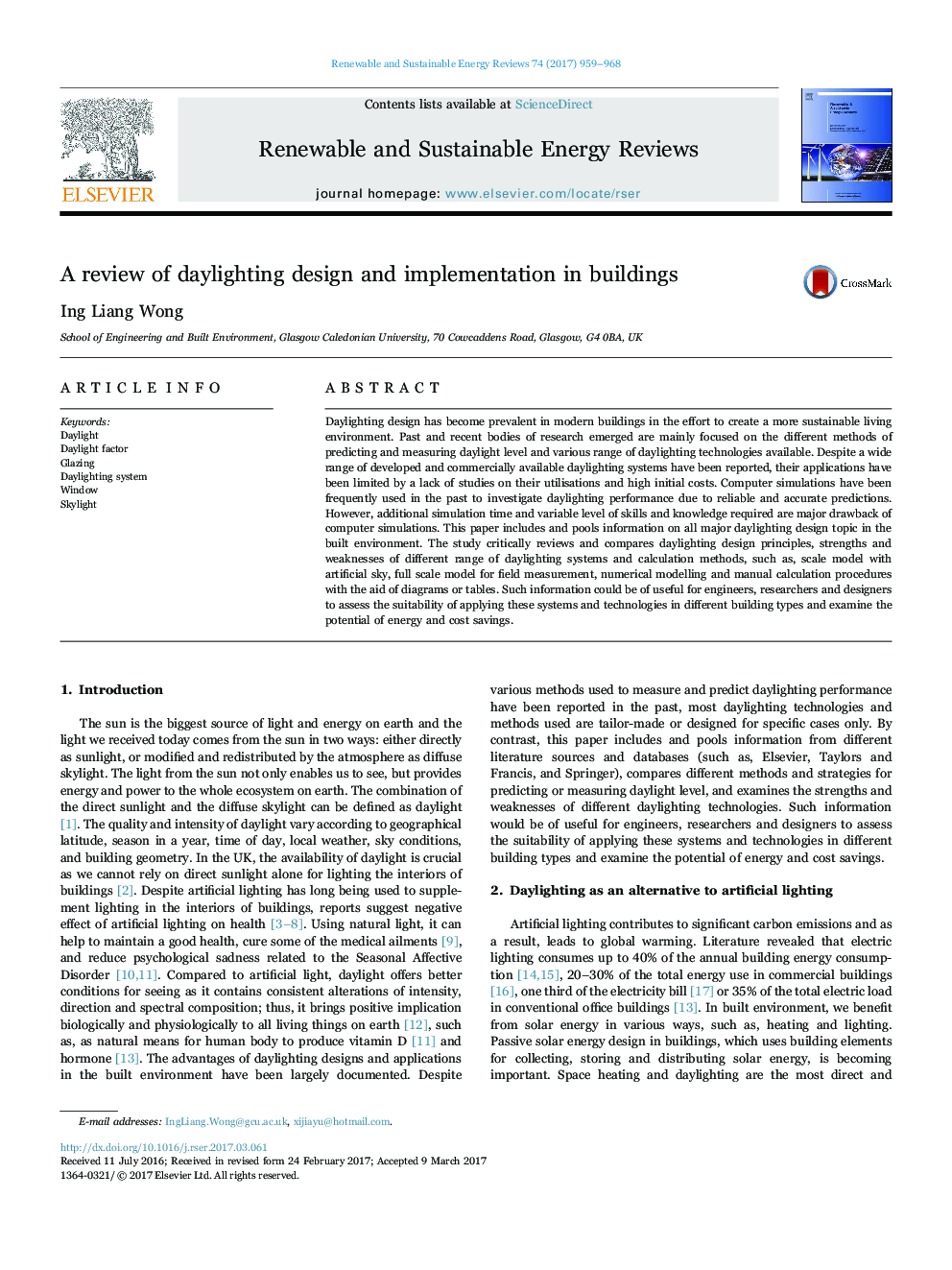| کد مقاله | کد نشریه | سال انتشار | مقاله انگلیسی | نسخه تمام متن |
|---|---|---|---|---|
| 5483170 | 1522312 | 2017 | 10 صفحه PDF | دانلود رایگان |
عنوان انگلیسی مقاله ISI
A review of daylighting design and implementation in buildings
ترجمه فارسی عنوان
بررسی طراحی و پیاده سازی نور روز در ساختمان ها
دانلود مقاله + سفارش ترجمه
دانلود مقاله ISI انگلیسی
رایگان برای ایرانیان
کلمات کلیدی
نور روز عامل نور روز، سرامیک سیستم نورپردازی، پنجره اشعه ماوراء بنفش
ترجمه چکیده
طراحی نور روز در ساختمان مدرن در تلاش برای ایجاد یک محیط زندگی پایدار تبدیل شده است. در گذشته و اخیر نهادهای تحقیقاتی به طور عمده بر روش های مختلف پیش بینی و اندازه گیری نور روز و طیف وسیعی از فن آوری های نور روز در دسترس متمرکز شده است. با وجود طیف گسترده ای از سیستم های روزمره توسعه یافته و تجاری که در دسترس قرار دارند، برنامه های کاربردی آنها توسط کمبود مطالعات در مورد کاربرد و هزینه های اولیه آنها محدود شده است. شبیه سازی های کامپیوتری در گذشته برای استفاده از قابلیت اطمینان روزانه با توجه به پیش بینی های قابل اطمینان و دقیق مورد استفاده قرار گرفته است. با این حال، زمان شبیه سازی اضافی و سطح متغیر مهارت ها و دانش مورد نیاز، نقص اصلی شبیه سازی کامپیوتری است. این مقاله شامل اطلاعاتی در مورد همه موضوع های مهم طراحی روزانه در محیط زیست است. این مطالعه به طور انتقادی از اصول طراحی روزمره، نقاط قوت و ضعف طیف وسیعی از سیستم های نور روز و روش های محاسبه، از قبیل مدل مقیاس با آسمان مصنوعی، مدل مقیاس کامل برای اندازه گیری میدان، مدل سازی عددی و روش های محاسبه دستی با کمک نمودارها، مقایسه می کند. یا جداول. چنین اطلاعاتی ممکن است مفید باشد برای مهندسان، محققان و طراحان برای ارزیابی مناسب بودن استفاده از این سیستم ها و فن آوری ها در انواع ساختمان های مختلف و بررسی پتانسیل انرژی و صرفه جویی در هزینه.
موضوعات مرتبط
مهندسی و علوم پایه
مهندسی انرژی
انرژی های تجدید پذیر، توسعه پایدار و محیط زیست
چکیده انگلیسی
Daylighting design has become prevalent in modern buildings in the effort to create a more sustainable living environment. Past and recent bodies of research emerged are mainly focused on the different methods of predicting and measuring daylight level and various range of daylighting technologies available. Despite a wide range of developed and commercially available daylighting systems have been reported, their applications have been limited by a lack of studies on their utilisations and high initial costs. Computer simulations have been frequently used in the past to investigate daylighting performance due to reliable and accurate predictions. However, additional simulation time and variable level of skills and knowledge required are major drawback of computer simulations. This paper includes and pools information on all major daylighting design topic in the built environment. The study critically reviews and compares daylighting design principles, strengths and weaknesses of different range of daylighting systems and calculation methods, such as, scale model with artificial sky, full scale model for field measurement, numerical modelling and manual calculation procedures with the aid of diagrams or tables. Such information could be of useful for engineers, researchers and designers to assess the suitability of applying these systems and technologies in different building types and examine the potential of energy and cost savings.
ناشر
Database: Elsevier - ScienceDirect (ساینس دایرکت)
Journal: Renewable and Sustainable Energy Reviews - Volume 74, July 2017, Pages 959-968
Journal: Renewable and Sustainable Energy Reviews - Volume 74, July 2017, Pages 959-968
نویسندگان
Ing Liang Wong,
